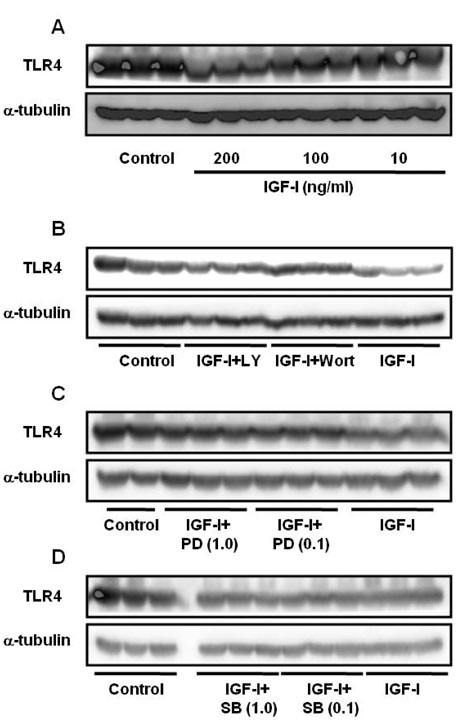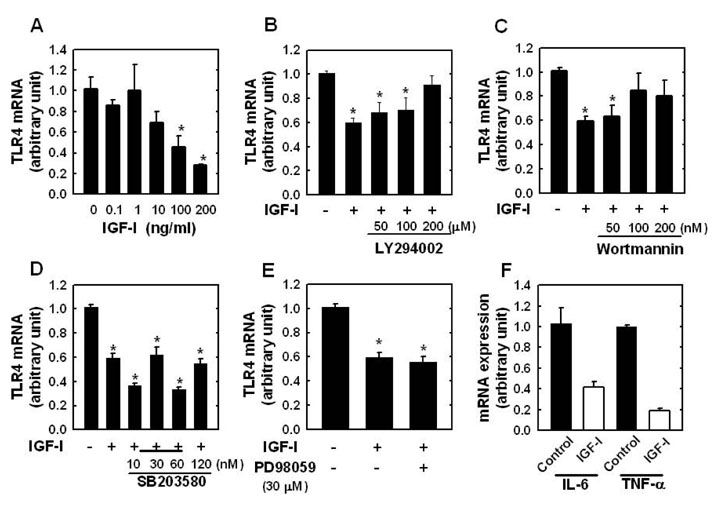Immune Netw.
2011 Aug;11(4):223-226. 10.4110/in.2011.11.4.223.
IGF-I Exerts an Anti-inflammatory Effect on Skeletal Muscle Cells through Down-regulation of TLR4 Signaling
- Affiliations
-
- 1Department of Exercise Science, College of Health Science, Ewha Womans University, Seoul 120-750, Korea. jun@ewha.ac.kr
- KMID: 1449814
- DOI: http://doi.org/10.4110/in.2011.11.4.223
Abstract
- Although exercise-induced growth factors such as Insulin-like growth factor-I (IGF-I) are known to affect various aspects of physiology in skeletal muscle cells, the molecular mechanism by which IGF-I modulates anti-inflammatory effects in these cells is presently unknown. Here, we showed that IGF-I stimulation suppresses the expression of toll-like receptor 4 (TLR4), a key innate immune receptor. A pharmacological inhibitor study further showed that PI3K/Akt signaling pathway is required for IGF-I-mediated negative regulation of TLR4 expression. Furthermore, IGF-I treatment reduced the expression of various NF-kappaB-target genes such as TNF-alpha and IL-6. Taken together, these findings indicate that the anti-inflammatory effect of exercise may be due, at least in part, to IGF-I-induced suppression of TLR4 and subsequent downregulation of the TLR4-dependent inflammatory signaling pathway.
Keyword
MeSH Terms
-
Cytokines
Down-Regulation
Insulin-Like Growth Factor I
Intercellular Signaling Peptides and Proteins
Interleukin-6
Muscle, Skeletal
Toll-Like Receptor 4
Tumor Necrosis Factor-alpha
Cytokines
Insulin-Like Growth Factor I
Intercellular Signaling Peptides and Proteins
Interleukin-6
Toll-Like Receptor 4
Tumor Necrosis Factor-alpha
Figure
Reference
-
1. Bruunsgaard H, Ladelund S, Pedersen AN, Schroll M, Jørgensen T, Pedersen BK. Predicting death from tumour necrosis factor-alpha and interleukin-6 in 80-year-old people. Clin Exp Immunol. 2003. 132:24–31.
Article2. Fessler MB, Rudel LL, Brown JM. Toll-like receptor signaling links dietary fatty acids to the metabolic syndrome. Curr Opin Lipidol. 2009. 20:379–385.
Article3. Oliveira AG, Carvalho BM, Tobar N, Ropelle ER, Pauli JR, Bagarolli RA, Guadagnini D, Carvalheira JB, Saad MJ. Physical exercise reduces circulating lipopolysaccharide and TLR4 activation and improves insulin signaling in tissues of DIO rats. Diabetes. 2011. 60:784–796.
Article4. Steinman RM, Hemmi H. Dendritic cells: translating innate to adaptive immunity. Curr Top Microbiol Immunol. 2006. 311:17–58.
Article5. Cooper DM, Radom-Aizik S, Schwindt C, Zaldivar F Jr. Dangerous exercise: lessons learned from dysregulated inflammatory responses to physical activity. J Appl Physiol. 2007. 103:700–709.
Article6. Walsh NP, Gleeson M, Shephard RJ, Gleeson M, Woods JA, Bishop NC, Fleshner M, Green C, Pedersen BK, Hoffman-Goetz L, Rogers CJ, Northoff H, Abbasi A, Simon P. Position statement. Part one: Immune function and exercise. Exerc Immunol Rev. 2011. 17:6–63.7. Petersen AM, Pedersen BK. The anti-inflammatory effect of exercise. J Appl Physiol. 2005. 98:1154–1162.
Article8. Stewart LK, Flynn MG, Campbell WW, Craig BA, Robinson JP, McFarlin BK, Timmerman KL, Coen PM, Felker J, Talbert E. Influence of exercise training and age on CD14+ cell-surface expression of toll-like receptor 2 and 4. Brain Behav Immun. 2005. 19:389–397.
Article9. Gleeson M, McFarlin B, Flynn M. Exercise and Toll-like receptors. Exerc Immunol Rev. 2006. 12:34–53.10. Eliakim A, Nemet D. Exercise training, physical fitness and the growth hormone-insulin-like growth factor-1 axis and cytokine balance. Med Sport Sci. 2010. 55:128–140.
Article11. Meng D, Shi X, Jiang BH, Fang J. Insulin-like growth factor-I (IGF-I) induces epidermal growth factor receptor transactivation and cell proliferation through reactive oxygen species. Free Radic Biol Med. 2007. 42:1651–1660.
Article12. Baeuerle PA, Baltimore D. NF-kappa B: ten years after. Cell. 1996. 87:13–20.13. Mathur N, Pedersen BK. Exercise as a mean to control low-grade systemic inflammation. Mediators Inflamm. 2008. 2008:109502.
Article14. Gomez-Merino D, Drogou C, Guezennec CY, Chennaoui M. Effects of chronic exercise on cytokine production in white adipose tissue and skeletal muscle of rats. Cytokine. 2007. 40:23–29.
Article
- Full Text Links
- Actions
-
Cited
- CITED
-
- Close
- Share
- Similar articles
-
- Sasa borealis extract exerts an antidiabetic effect via activation of the AMP-activated protein kinase
- Effect of IGF-I on Hair Growth Is Related to the Anti-Apoptotic Effect of IGF-I and Up-Regulation of PDGF-A and PDGF-B
- p62 Negatively Regulates TLR4 Signaling via Functional Regulation of the TRAF6-ECSIT Complex
- The inhibition of inflammatory molecule expression on 3T3-L1 adipocytes by berberine is not mediated by leptin signaling
- Grape seed proanthocyanidin extract ameliorates murine autoimmune arthritis through regulation of TLR4/MyD88/NF-κB signaling pathway



